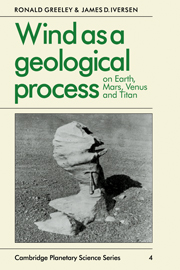Book contents
- Frontmatter
- Contents
- Preface
- 1 Wind as a geological process
- 2 The aeolian environment
- 3 Physics of particle motion
- 4 Aeolian abrasion and erosion
- 5 Aeolian sand deposits and bedforms
- 6 Interaction of wind and topography
- 7 Windblown dust
- Appendix A Nomenclature and symbols
- Appendix B Small-scale modeling of aeolian phenomena in the wind tunnel
- Glossary
- References
- Index
5 - Aeolian sand deposits and bedforms
Published online by Cambridge University Press: 16 November 2009
- Frontmatter
- Contents
- Preface
- 1 Wind as a geological process
- 2 The aeolian environment
- 3 Physics of particle motion
- 4 Aeolian abrasion and erosion
- 5 Aeolian sand deposits and bedforms
- 6 Interaction of wind and topography
- 7 Windblown dust
- Appendix A Nomenclature and symbols
- Appendix B Small-scale modeling of aeolian phenomena in the wind tunnel
- Glossary
- References
- Index
Summary
Introduction
Sand dunes and deserts are intimately linked in the minds of most people and epitomize aeolian processes. The most impressive sand dunes occur in vast sand seas, often called ergs – an arabic word for wind-laid sands. Almost all ergs occur in desert basins, generally in areas downwind from terrain experiencing high rates of deflation. Sand then tends to collect where net transportation is low, as in topographical basins or traps.
Wilson (1971, 1973) surveyed all ergs on Earth that are larger than 12 000 km2 and identified 58 such areas, mostly within regions receiving less than 15 cm precipitation per year. Despite the link between sand dunes and deserts, the two need not occur together. Many deserts lack dunes entirely. And dunes may occur in non-desert areas, such as along coastlines and in river flood plains. Although dunes are aesthetically pleasing, they represent only one form of aeolian deposit.
Bagnold (1941) first described the various processes involved in dune formation and sand migration. His model has been modified slightly and amplified by Hunter (1977) and Kocurek & Dott (1981), who describe three basic processes of deposition by windblown sand: (1) tractional deposition (Bagnold's ‘accretion’ process), in which grains moving by saltation and impact creep come to rest in a sheltered position, (2) grainfall deposition, in which particles settle out of the air, usually in zones of flow separation; Bagnold distinguished (1) from (2) in that, during grainfall, the grains do not move forward when they reach the ground, whereas in tractional deposition, they may bounce along until they find a stable position among other grains, and (3) grainflow deposition, or avalanching, in which grains reach the brink of a dune then avalanche down the slip face (Fig. 5.1).
- Type
- Chapter
- Information
- Wind as a Geological ProcessOn Earth, Mars, Venus and Titan, pp. 145 - 198Publisher: Cambridge University PressPrint publication year: 1985



